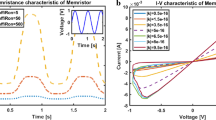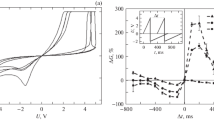Abstract
Nowadays, the task of creating and training spiking neural networks (SNN) is extremely relevant due to their high energy efficiency achieved by implementing such networks via neuromorphic hardware.
Especially interesting is the possibility of building SNNs based on memristors, which have properties that potentially allow them to be used as analog synapses. With that in mind, it seems relevant to study spike networks built upon plasticity rules that correspond to the experimentally observed nonlinear laws of conductivity change in memristors.
Earlier it was shown that spiking neural networks trained with a biologically inspired local STDP (Spike-Timing-Dependent Plasticity) rule are capable of solving classification problems successfully. In addition, it was also demonstrated that classification problems can also be solved with spiking neural networks operating with a plasticity rule that models the change in conductivity in nanocomposite (NC) memristors.
This paper presents a continuation of the study of the applicability of memristive plasticity rules on the handwritten digit recognition problem. Two types of memristive plasticity are compared: for nanocomposite and PPX memristors. It is shown that both models can successfully solve the classification problem, and the key differences between them are identified.
Access this chapter
Tax calculation will be finalised at checkout
Purchases are for personal use only
Similar content being viewed by others
References
Camuñas-Mesa, L.A., Linares-Barranco, B., Serrano-Gotarredona, T.: Neuromorphic spiking neural networks and their memristor-cmos hardware implementations. Materials 12 (2019). https://doi.org/10.3390/ma12172745
Davies, M., et al.: Loihi: a neuromorphic manycore processor with on-chip learning. IEEE Micro 38(1), 82–99 (2018). https://doi.org/10.1109/MM.2018.112130359
Demin, V., et al.: Necessary conditions for STDP-based pattern recognition learning in a memristive spiking neural network. Neural Networks 134, 64–75 (2021)
Diehl, P.U., Cook, M.: Unsupervised learning of digit recognition using Spike-Timing-Dependent Plasticity. Front. Comput. Neurosci. (2015). https://doi.org/10.3389/fncom.2015.00099
Hazan, H., Saunders, D.J., Khan, H., Patel, D., Sanghavi, D.T., Siegelmann, H.T., Kozma, R.: Bindsnet: a machine learning-oriented spiking neural networks library in python. Front. Neuroinform. 12 (2018). https://doi.org/10.3389/fninf.2018.00089
Indiveri, G., Corradi, F., Qiao, N.: Neuromorphic architectures for spiking deep neural networks. In: 2015 IEEE International Electron Devices Meeting, pp. 4.2.1-4.2.4 (2016). https://doi.org/10.1109/IEDM.2015.7409623
Ismail, M., Chand, U., Mahata, C., Nebhen, J., Kim, S.: Demonstration of synaptic and resistive switching characteristics in w/tio2/hfo2/tan memristor crossbar array for bioinspired neuromorphic computing. J. Mater. Sci. Technol. 96, 94–102 (2022). https://doi.org/10.1016/j.jmst.2021.04.025. https://www.sciencedirect.com/science/article/pii/S1005030221004655
Lapkin, D.A., Emelyanov, A.V., Demin, V.A., Berzina, T.S., Erokhin, V.V.: Spike-timing-dependent plasticity of polyaniline-based memristive element. Microelectron. Eng. 185–186, 43–47 (2018). https://doi.org/10.1016/j.mee.2017.10.017. https://www.sciencedirect.com/science/article/pii/S016793171730357X
Minnekhanov, A.A., et al.: On the resistive switching mechanism of parylene-based memristive devices. Org. Electron. 74, 89–95 (2019). https://doi.org/10.1016/j.orgel.2019.06.052
Paugam-Moisy, H., Bohte, S.M.: Computing with spiking neuron networks. In: Rozenberg, G., Back, T., Kok, J. (eds.) Handbook of Natural Computing, pp. 335–376. Springer, Heidelberg (2012). http://homepages.cwi.nl/~sbohte/publication/paugam_moisy_bohte_SNNChapter.pdf. https://doi.org/10.1007/978-3-540-92910-9_10
Pedregosa, F., et al.: Scikit-learn: machine learning in python. J. Mach. Learn. Res. 12, 2825–2830 (2011)
Prudnikov, N.V., et al.: Associative STDP-like learning of neuromorphic circuits based on polyaniline memristive microdevices. J. Phys. D: Appl. Phys. 53(41), 414,001 (2020). https://doi.org/10.1088/1361-6463/ab9262
Qu, L., Zhao, Z., Wang, L., Wang, Y.: Efficient and hardware-friendly methods to implement competitive learning for spiking neural networks. Neural Comput. Appl. 32(17), 13479–13490 (2020). https://doi.org/10.1007/s00521-020-04755-4
Querlioz, D., Dollfus, P., Bichler, O., Gamrat, C.: Learning with memristive devices: How should we model their behavior? In: 2011 IEEE/ACM International Symposium on Nanoscale Architectures, pp. 150–156 (2011). https://doi.org/10.1109/NANOARCH.2011.5941497
Rajendran, B., Sebastian, A., Schmuker, M., Srinivasa, N., Eleftheriou, E.: Low-power neuromorphic hardware for signal processing applications: A review of architectural and system-level design approaches. IEEE Signal Process. Mag. 36(6), 97–110 (2019). https://doi.org/10.1109/MSP.2019.2933719
van Rossum, M.C.W., Bi, G.Q., Turrigiano, G.G.: Stable hebbian learning from spike timing-dependent plasticity. J. Neurosci. 20(23), 8812–8821 (2000). http://www.jneurosci.org/content/20/23/8812.long
Ryu, J.H., Mahata, C., Kim, S.: Long-term and short-term plasticity of Ta2O5/HfO2 memristor for hardware neuromorphic application. J. Alloys Compounds 850, 156,675 (2021). https://doi.org/10.1016/j.jallcom.2020.156675. https://www.sciencedirect.com/science/article/pii/S0925838820330395
Saïghi, S., Mayr, C.G., Serrano-Gotarredona, T., Schmidt, H., Lecerf, G., Tomas, J., Grollier, J., Boyn, S., Vincent, A.F., Querlioz, D., La Barbera, S., Alibart, F., Vuillaume, D., Bichler, O., Gamrat, C., Linares-Barranco, B.: Plasticity in memristive devices for spiking neural networks. Front. Neurosci. 9, 51 (2015). https://doi.org/10.3389/fnins.2015.00051
Sboev, A.G., et al.: Self-adaptive STDP-based learning of a spiking neuron with nanocomposite memristive weights. Nanotechnology 31(4), 045,201:1–10 (2019). https://doi.org/10.1088/1361-6528/ab4a6d. http://iopscience.iop.org/article/10.1088/1361-6528/ab4a6d
Serrano-Gotarredona, T., Masquelier, T., Prodromakis, T., Indiveri, G., Linares-Barranco, B.: STDP and STDP variations with memristors for spiking neuromorphic learning systems. Front. Neurosci. 7, 2 (2013)
Taherkhani, A., Belatreche, A., Li, Y., Cosma, G., Maguire, L.P., McGinnity, T.: A review of learning in biologically plausible spiking neural networks. Neural Networks 122, 253–272 (2020).https://doi.org/10.1016/j.neunet.2019.09.036. http://www.sciencedirect.com/science/article/pii/S0893608019303181
Wang, Z., et al.: Fully memristive neural networks for pattern classification with unsupervised learning. Nature Electron. 1(2), 137–145 (2018). https://doi.org/10.1038/s41928-018-0023-2
Acknowledgements
This work has been supported by the Russian Science Foundation grant No.21-11-00328 and has been carried out using computing resources of the federal collective usage center Complex for Simulation and Data Processing for Mega-science Facilities at NRC “Kurchatov Institute”, http://ckp.nrcki.ru/.
Author information
Authors and Affiliations
Editor information
Editors and Affiliations
Rights and permissions
Copyright information
© 2022 The Author(s), under exclusive license to Springer Nature Switzerland AG
About this paper
Cite this paper
Sboev, A., Davydov, Y., Rybka, R., Vlasov, D., Serenko, A. (2022). A Comparison of Two Variants of Memristive Plasticity for Solving the Classification Problem of Handwritten Digits Recognition. In: Klimov, V.V., Kelley, D.J. (eds) Biologically Inspired Cognitive Architectures 2021. BICA 2021. Studies in Computational Intelligence, vol 1032. Springer, Cham. https://doi.org/10.1007/978-3-030-96993-6_48
Download citation
DOI: https://doi.org/10.1007/978-3-030-96993-6_48
Published:
Publisher Name: Springer, Cham
Print ISBN: 978-3-030-96992-9
Online ISBN: 978-3-030-96993-6
eBook Packages: Intelligent Technologies and RoboticsIntelligent Technologies and Robotics (R0)




